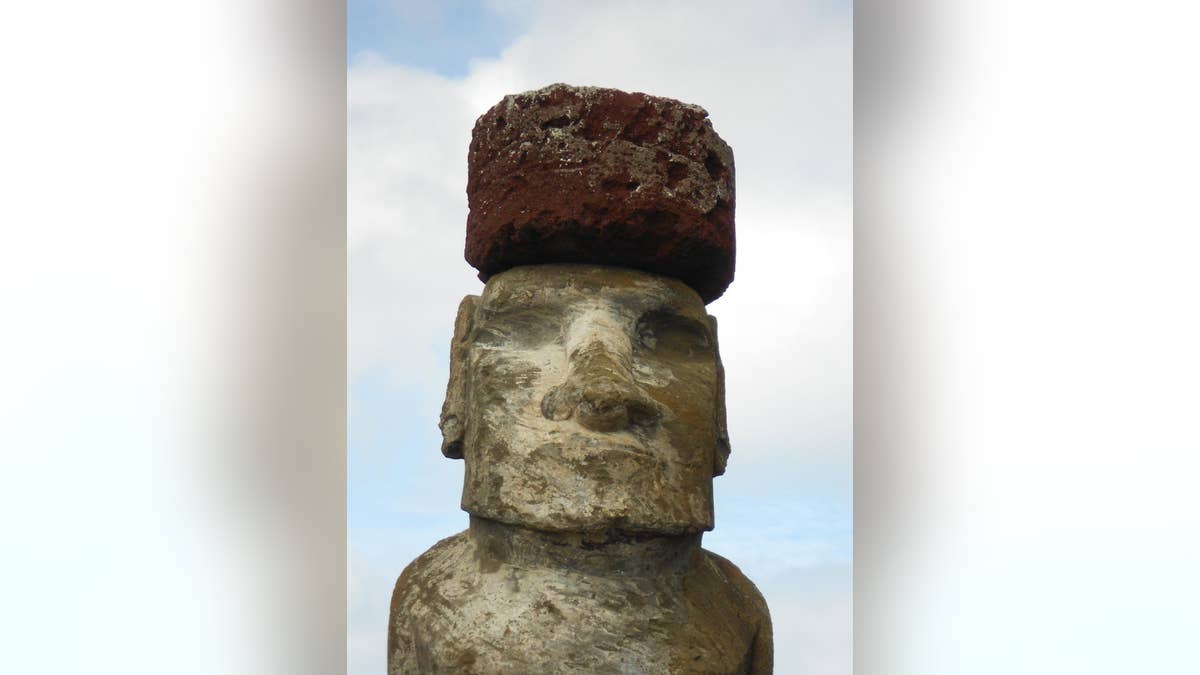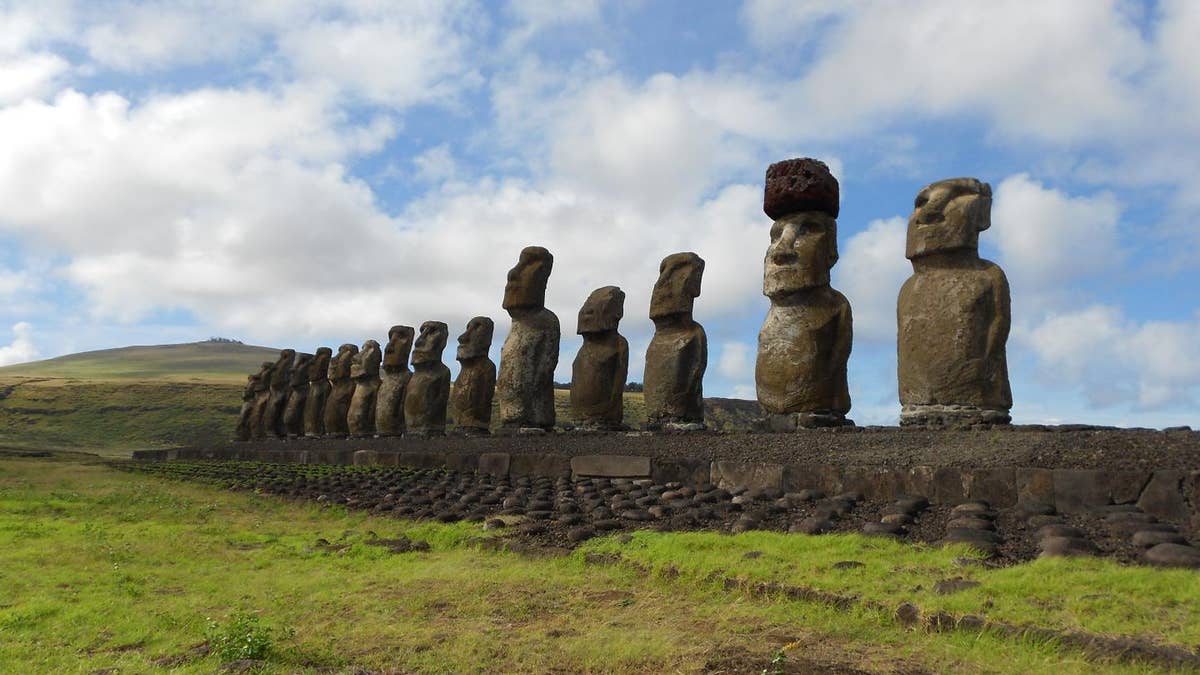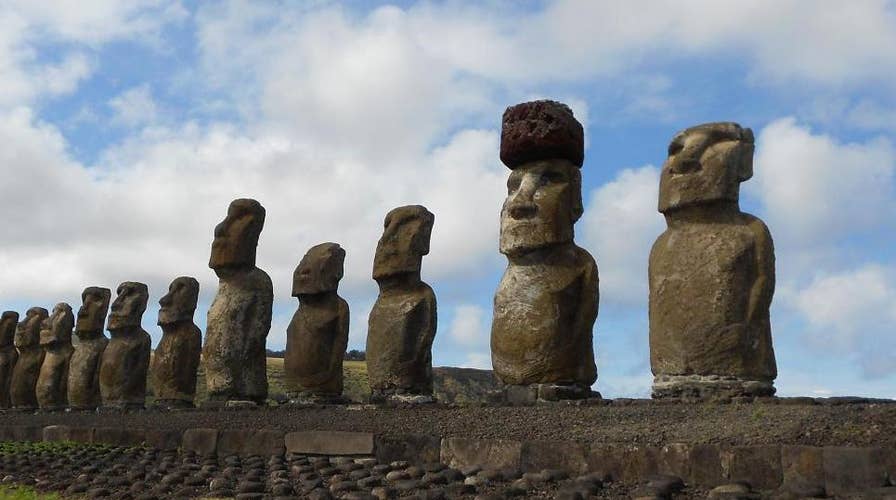Easter Island mystery solved?
Researchers say they figured out how the ancient people of Easter Island put 12-ton hats on the mysterious statues.
Experts have worked out how the ancient people of Easter Island, or Rapa Nui, were able to place massive stone hats on the island’s famous statues.
A team of researchers that includes experts from Binghamton University, State University at New York, worked out that the island’s inhabitants used a technique called “parbuckling” that uses ropes and a ramp.
"Of the many questions that surround the island's past, two tend to stand out: How did people of the past move such massive statues (moai) and how did they place such massive stone hats (pukao) on top of their heads?" said Carl Lipo, a professor of anthropology at Binghamton University, in a statement.
EASTER ISLAND'S ANCIENT CIVILIZATION WAS NOT DESTROYED BY WARFARE, EXPERTS SAY
With limited resources at their disposal, archaeologists have wondered how the islanders were able to move the cylindrical pukao, which weigh 13.2 tons (12 metric tons), across long distances.

A moai adorned with a red pukao (Sean Hixon)
After taking photos of the pukao, 3-D modeling was used to reveal key details of the giant stone hats, which are carved from red scoria, or volcanic rock.
Experts found that pukao were most likely rolled from the quarry to the location of the moai, and rolled up large ramps using the parbuckling technique.
PART OF EASTER ISLAND MYSTERY SOLVED
"In parbuckling, a line would have been wrapped around the pukao cylinder, and then people would have pulled the rope from the top of the platform," said Lipo. "This approach minimizes the effort needed to roll the statue up the ramp. Like the way in which the statues were transported, parbuckling was a simple and elegant solution that required minimum resources and effort."

A restored statue platform with standing moai on the south coast of Rapa Nui. Note that one of the moai is adorned with a red scoria pukao. (Sean Hixon)
Previous theories about pukao transport include sliding the stone hats up a ramp or gradually building a pile of stones beneath them.
"Easter Island is often treated as a place where prehistoric people acted irrationally, and that this behavior led to a catastrophic ecological collapse," said Lipo. "The archaeological evidence, however, shows us that this picture is deeply flawed and badly misrepresents what people did on the island, and how they were able to succeed on a tiny and remote place for over 500 years."
Experts from Penn State, the University of Oregon and the University of Arizona also participated in the research. The pukao studt was published in The Journal of Archaeological Sciences.
EASTER ISLAND ARCHAEOLOGY PROJECT DIGS UP ISLAND'S SECRETS
The remote Pacific island, which is located more than 2,000 miles off the coast of Chile, continues to be a source of fascination for historians. In 2016, research conducted on artifacts from the island questioned the theory that the ancient civilization there was destroyed by warfare.
Experts, also from Binghamton University, studied hundreds of ancient items found on the shores of Easter Island. Previously, the artifacts were thought to be spear points, but analysis reveals that they were likely general purpose tools.
Carved from obsidian, or volcanic glass, thousands of the triangular objects, known as mata'a, litter the surface of the island.
Some scientists have estimated, that, at its height, Easter Island’s population may have been as high as 20,000, but fell over centuries after the island’s trees and palms were cut down to build canoes and transport its famous giant statues. One theory suggests that the deforestation led to soil erosion, impacting the island’s ability to support wildlife and farming, and the collapse of its civilization.
When the Dutch arrived at the island in 1722, its population was 3,000 or less. Only 111 inhabitants were living on Easter Island by 1877.
However, other experts have questioned whether Easter Island ever supported a large population, citing instead the arrival of Europeans, who brought diseases and took islanders away as slaves.
Follow James Rogers on Twitter @jamesjrogers





















